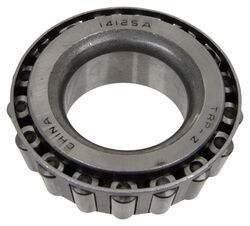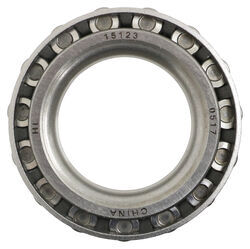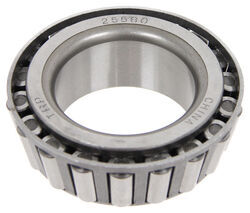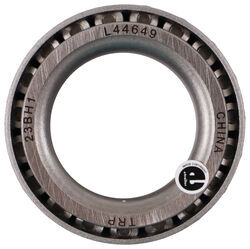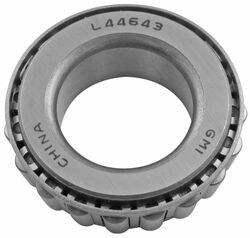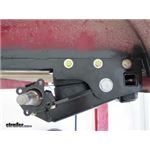
Determining Axle Weight Capacity in Relation to Bolt Patterns, Brake Size and Bearings
Question:
Two answers end with this statement: "The next step would be to measure bolt pattern on the hub, size of brakes, and bearing part numbers, to narrow down the capacity of your axle." That old adage about assumptions comes to mind. Could you give some rule of thumb to relationship of axle capacity, bolt pattern on the hub, size of brakes... Thanks and BTW your FAQ section is great!
asked by: Tim
Helpful Expert Reply:
There are commonalities between bearing combinations, bolt patterns and brake sizes for certain axle capacities. Starting at the low end, axles with a 2,000 lb capacity can use a 4 or 5 bolt hub with a brake size of 7 inches x 1-1/4 inches using inner and outer bearings # L44643 or # L44649.
Axles with a 3,500 lb capacity can use a 4,5 or 6 bolt hub with a brake size of 10 inches x 2-1/4 inches, with outer bearing # L44649 and inner bearing # L68149.
For axles with a capacity of 4,400 lbs, a 6 bolt hub is needed with a brake size of 10 inches x 2-1/4 inches with bearings # L68149 and # LM67048.
Axles with a 5,200 lb capacity use a 6 bolt hub with a brake size of 12 inches x 2 inches and bearings # LM67048 and # 25580. The only difference between those axles and 6,000 lb capacity axles is that the 6k capacity uses one different bearing, # 15123.
Finally for the recreational towing market, there is the 7,000 lb capacity axle, which uses an 8 bolt hub with 12 inch x 2 inch brakes and bearings # 25580 and # 14125A. This is admittedly a lot of information to take in, so I have linked a help article which contains this information in a chart that you may find useful.

Products Referenced in This Question
Replacement Trailer Hub Bearing - 14125A
- Trailer Bearings Races Seals Caps
- Bearings
- Standard Bearings
- 1.250 Inch I.D.
- Bearing 14125A
- Race 14276
- 5200 lbs Axle
- 6000 lbs Axle
- 7000 lbs Axle
- TruRyde
more information >
Replacement Trailer Hub Bearing - 15123
- Trailer Bearings Races Seals Caps
- Bearings
- Standard Bearings
- 1.250 Inch I.D.
- Bearing 15123
- Race 15245
- 5200 lbs Axle
- 6000 lbs Axle
- 7000 lbs Axle
- etrailer
more information >
Replacement Trailer Hub Bearing - 25580
- Trailer Bearings Races Seals Caps
- Bearings
- Standard Bearings
- 1.750 Inch I.D.
- Bearing 25580
- Race 25520
- 10000 lbs Axle
- 6000 lbs Axle
- 7000 lbs Axle
- 8000 lbs Axle
- 9000 lbs Axle
- etrailer
more information >
Replacement Trailer Hub Bearing - L44649
- Trailer Bearings Races Seals Caps
- Bearings
- Standard Bearings
- 1.063 Inch I.D.
- Bearing L44649
- Race L44610
- 3500 lbs Axle
- etrailer
more information >
Replacement Trailer Hub Bearing - L68149
- Trailer Bearings Races Seals Caps
- Bearings
- Standard Bearings
- 1.378 Inch I.D.
- Bearing L68149
- Race L68111
- 3500 lbs Axle
- etrailer
more information >
Replacement Trailer Hub Bearing - LM67048
- Trailer Bearings Races Seals Caps
- Bearings
- Standard Bearings
- 1.250 Inch I.D.
- Bearing LM67048
- Race LM67010
- 5000 lbs Axle
- 6000 lbs Axle
- etrailer
more information >
Product Page this Question was Asked From
Replacement Trailer Hub Bearing - L44643
- Trailer Bearings Races Seals Caps
- Bearings
- Standard Bearings
- 1.000 Inch I.D.
- Bearing L44643
- Race L44610
- 2000 lbs Axle
- etrailer
more information >
Featured Help Information
Miscellaneous Media

Continue Researching
- Search Results: wheels
- Search Results: trailer axles
- Q&A: Can I Guess or Estimate Axle Weight Capacity By Number of Lug Nuts
- Q&A: Higher Capacity Axle Replacement for Dexter 4,400 lb Axles on 2019 Keystone Laredo 335MK
- Q&A: How to Determine Weight Capacity of Trailer Axle
- Shop: Trailer Axle w/ Electric Brakes - Easy Grease - 6 on 5-1/2 Bolt Pattern - 95" Long - 6,000 lbs
- Shop: Aluminum Liger Trailer Wheel - 15" x 6" Rim - 6 on 5-1/2 - Gunmetal Gray
- Shop: Westlake ST235/75R15 Off-Road Tire w/ 15" Liger Aluminum Wheel - 6 on 5-1/2 - Glossy Black
- Shop: Aluminum Liger Trailer Wheel - 15" x 5" Rim - 5 on 4-1/2 - Glossy Black
- Shop: Kenda Karrier ST205/75R15 Radial Trailer Tire with 15" Black Mod Wheel - 5 on 4-1/2 - LR D
- Article: How to Tell the Weight Rating of a Trailer Axle
- Shop: Trailer Axle w/ Electric Brakes - Easy Grease - 8 on 6-1/2 Bolt Pattern - 95" Long - 7,000 lbs
- Video: Review of Lionshead Trailer Tires and Wheels - Liger Wheel - LH37FR
- Search Results: trailer lights
- Search Results: trailer wheels
- Search Results: trailer decking
- Search Results: trailer drop axle
- Q&A: Low Voltage on Brake Output of Factory Brake Controller on a 2008 GMC Sierra 2500HD
- Article: 5 Tell-Tale Signs It’s Time to Replace Your Trailer’s Leaf Springs
- Shop: Timbren Axle-Less Trailer Suspension - Standard Duty - No Drop - 5 Bolt Flange - 5,200 lbs
- Video: Review of Taskmaster Trailer Tires and Wheels - Off Road Tire with Wheel - TA75RR
- Search Results: trailer tires wheels
- Q&A: Info Needed for Work and Play, Forest River Toy Hauler Axle Upgrade to Higher Capacity
- Shop: Trailer Hitch
- Q&A: Trailer Suspension Hanger Kit for Slipper Springs and 38 inch Wheelbase
- Article: Trailer Wiring Diagrams
- Q&A: Location of the 40-Amp Fuse for the 2006 Chevrolet Silverado Tow Package
- Video: Timbren Axle-Less Trailer Suspension System Installation
- Article: Most Popular Wheel Bearings
- Shop: Trailer Wiring




